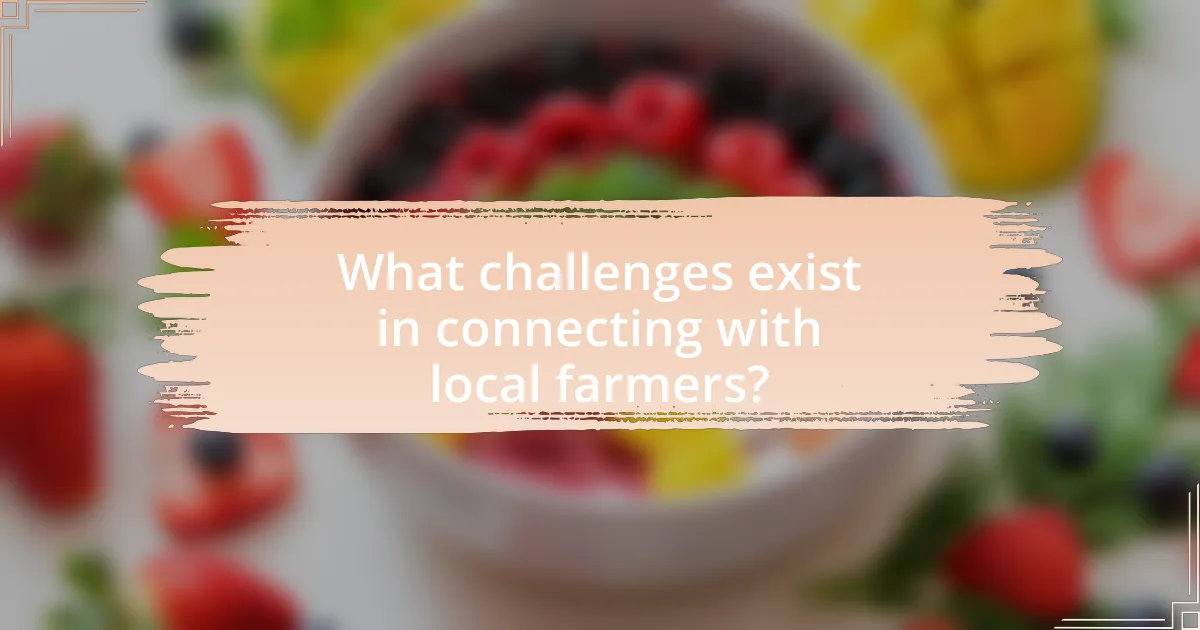Connecting with local farmers involves establishing direct relationships with agricultural producers within a community, which can enhance food security, promote sustainable practices, and strengthen local economies. Community engagement in agriculture fosters collaboration, allowing farmers to adapt their practices to meet local needs while benefiting from increased market access and consumer relationships. This article explores the significance of community engagement, the benefits it brings to local farmers and consumers, and the challenges faced in building these connections. Additionally, it discusses effective strategies for overcoming barriers and enhancing relationships between farmers and the community, emphasizing the role of technology and local initiatives in facilitating these interactions.

What does it mean to connect with local farmers?
Connecting with local farmers means establishing direct relationships with agricultural producers in a specific community. This connection often involves purchasing food directly from farmers, participating in community-supported agriculture (CSA) programs, or engaging in local food markets. Such interactions foster a better understanding of food sources, promote sustainable agricultural practices, and strengthen local economies. Research indicates that communities with strong ties to local farmers experience increased food security and enhanced community resilience, as evidenced by studies showing that local food systems can reduce transportation emissions and support biodiversity.
Why is community engagement important in agriculture?
Community engagement is important in agriculture because it fosters collaboration between farmers and local communities, leading to sustainable agricultural practices and improved food security. Engaged communities can provide valuable insights into local needs and preferences, which helps farmers adapt their practices to better serve those needs. Research indicates that regions with strong community engagement in agriculture experience enhanced resilience to economic and environmental challenges, as seen in studies conducted by the Food and Agriculture Organization, which highlight the role of community participation in promoting sustainable farming methods and increasing crop yields.
How does community engagement benefit local farmers?
Community engagement benefits local farmers by enhancing their market access and fostering stronger relationships with consumers. When farmers actively participate in community events, they can showcase their products directly to local buyers, which increases sales opportunities. Research indicates that farmers who engage with their communities often experience a 20% increase in sales due to direct consumer relationships, as highlighted in the study “The Economic Impact of Local Food Systems” by the USDA. Additionally, community engagement helps farmers gain valuable feedback on their products, allowing them to adapt and improve based on consumer preferences, ultimately leading to better market alignment and sustainability.
What role does community engagement play in sustainable farming?
Community engagement plays a crucial role in sustainable farming by fostering collaboration between farmers and local communities, which enhances agricultural practices and promotes environmental stewardship. Engaged communities contribute to sustainable farming by sharing knowledge, resources, and support, leading to improved crop diversity and resilience. Research indicates that farms involved in community-supported agriculture (CSA) programs often see increased profitability and reduced environmental impact, as these initiatives encourage local consumption and reduce transportation emissions. Additionally, community engagement helps build trust and transparency, allowing farmers to better understand consumer preferences and adapt their practices accordingly, ultimately leading to more sustainable food systems.
How can individuals and organizations connect with local farmers?
Individuals and organizations can connect with local farmers through community-supported agriculture (CSA) programs, farmers’ markets, and agricultural cooperatives. These platforms facilitate direct interactions between consumers and farmers, allowing individuals to purchase fresh produce and learn about farming practices. For instance, a study by the USDA indicates that participation in CSAs has increased by 20% over the past decade, highlighting the growing interest in local food systems. Additionally, organizations can collaborate with local agricultural extension offices to host workshops and events that promote sustainable farming and community engagement.
What methods are effective for building relationships with farmers?
Effective methods for building relationships with farmers include regular communication, community involvement, and providing support through resources and education. Regular communication fosters trust and understanding, allowing farmers to express their needs and concerns. Community involvement, such as participating in local events or agricultural fairs, strengthens ties and demonstrates commitment to the farming community. Providing support through resources, such as access to training programs or financial assistance, enhances farmers’ capabilities and shows a genuine interest in their success. These methods are validated by studies indicating that strong community ties lead to improved agricultural practices and economic resilience among farmers.
How can technology facilitate connections between consumers and farmers?
Technology facilitates connections between consumers and farmers by enabling direct communication and transactions through digital platforms. For instance, mobile applications and websites allow consumers to access information about local farms, view product availability, and place orders directly, thereby reducing the need for intermediaries. According to a study by the USDA, farmers who utilize online marketing tools can increase their sales by up to 30%, demonstrating the effectiveness of technology in bridging the gap between producers and consumers. Additionally, social media platforms enable farmers to share their stories and practices, fostering transparency and trust, which enhances consumer engagement and loyalty.

What are the benefits of connecting with local farmers?
Connecting with local farmers provides numerous benefits, including access to fresh, seasonal produce, which enhances nutrition and supports local economies. By purchasing directly from farmers, consumers often receive higher quality food that is harvested at peak ripeness, leading to better flavor and nutritional value. Additionally, engaging with local farmers fosters community relationships, promotes sustainable agricultural practices, and reduces the carbon footprint associated with transporting food over long distances. Studies indicate that local food systems can significantly boost local economies; for instance, a report from the USDA shows that for every dollar spent on local food, approximately $0.68 stays within the local community.
How does supporting local farmers impact the community?
Supporting local farmers positively impacts the community by enhancing local economies, promoting food security, and fostering social connections. When consumers buy from local farmers, they keep money within the community, which can lead to job creation and increased local investment. According to a study by the American Farmland Trust, every dollar spent on local food generates an estimated $1.76 in economic activity. Additionally, supporting local agriculture contributes to food security by providing fresh, nutritious produce, reducing reliance on distant food sources. This practice also strengthens community ties, as local farmers often engage in community events and initiatives, fostering a sense of belonging and collaboration among residents.
What economic advantages arise from buying local produce?
Buying local produce supports the local economy by keeping money within the community, which can lead to job creation and increased economic stability. When consumers purchase from local farmers, a larger portion of the money spent remains in the area compared to buying from large, distant suppliers. Studies indicate that for every dollar spent on local food, approximately 68% stays in the local economy, compared to only 43% for non-local food. This retention of funds can enhance local businesses, promote sustainable agricultural practices, and foster community resilience.
How does connecting with local farmers enhance food security?
Connecting with local farmers enhances food security by creating a more resilient and accessible food supply chain. When communities engage with local farmers, they reduce reliance on distant food sources, which can be vulnerable to disruptions such as transportation issues or global market fluctuations. Studies show that local food systems can increase food availability and diversity, as they often provide fresh produce that meets local dietary needs. Additionally, local farmers are more likely to adapt their practices to the specific environmental and economic conditions of their communities, further strengthening food security. For instance, a report by the USDA indicates that local food initiatives can lead to a 20% increase in food access in underserved areas, demonstrating the tangible benefits of connecting with local agricultural producers.
What social benefits come from engaging with local farmers?
Engaging with local farmers fosters community cohesion and enhances social networks. This interaction promotes trust and collaboration among community members, as local farmers often participate in community events and initiatives. Research indicates that communities with strong local food systems experience increased social capital, which is defined as the networks of relationships among people who live and work in a particular society. For instance, a study by the American Farmland Trust found that local food initiatives can lead to improved community engagement and a sense of belonging, as residents support their local economy and build relationships with those who produce their food.
How does community engagement foster a sense of belonging?
Community engagement fosters a sense of belonging by creating opportunities for individuals to connect with one another through shared interests and activities. When people participate in community events, such as farmers’ markets or local agricultural initiatives, they build relationships and networks that enhance social cohesion. Research indicates that social interactions in community settings can lead to increased feelings of trust and support among members, which are critical components of belonging. For instance, a study published in the Journal of Community Psychology found that active participation in community activities significantly correlates with higher levels of perceived social support and belongingness. This evidence underscores the importance of community engagement in cultivating a strong sense of belonging among individuals.
What educational opportunities arise from connecting with farmers?
Connecting with farmers provides educational opportunities such as hands-on learning about sustainable agriculture practices, food production, and environmental stewardship. Engaging directly with farmers allows individuals to gain insights into crop cycles, soil health, and pest management techniques, which are essential for understanding modern farming. Research indicates that community-supported agriculture programs enhance knowledge about local food systems and promote awareness of nutritional benefits associated with fresh produce. Additionally, workshops and farm tours often organized by farmers serve as platforms for sharing best practices and innovative farming methods, further enriching the educational experience for participants.

What challenges exist in connecting with local farmers?
Connecting with local farmers presents several challenges, including geographical barriers, lack of communication channels, and differing agricultural practices. Geographical barriers can limit access to farmers, especially in rural areas where transportation infrastructure may be inadequate. Additionally, many farmers may not have established communication channels, making it difficult for consumers or organizations to reach out effectively. Furthermore, differing agricultural practices and philosophies can create misunderstandings or misalignments in goals between farmers and those seeking to engage with them. These challenges can hinder the development of strong community ties and collaborative efforts.
What barriers do consumers face when trying to engage with farmers?
Consumers face several barriers when trying to engage with farmers, including lack of access to information, geographical distance, and limited availability of local markets. Access to information is often hindered by insufficient communication channels between farmers and consumers, making it difficult for consumers to learn about local produce and farming practices. Geographical distance can pose a significant challenge, especially in rural areas where farmers may be located far from urban centers, limiting consumers’ ability to visit farms or farmers’ markets. Additionally, limited availability of local markets restricts opportunities for consumers to purchase directly from farmers, as many areas lack sufficient venues for such transactions. These barriers collectively impede meaningful engagement between consumers and farmers, affecting community connections and local food systems.
How can transportation issues affect access to local produce?
Transportation issues can significantly limit access to local produce by creating barriers in the distribution process. When transportation infrastructure is inadequate, such as poorly maintained roads or lack of reliable delivery services, farmers may struggle to reach markets efficiently. This inefficiency can lead to increased costs and spoilage of perishable goods, ultimately reducing the availability of fresh produce for consumers. For instance, a study by the USDA found that transportation costs can account for up to 30% of the total expenses for small-scale farmers, which directly impacts their ability to supply local markets consistently.
What misconceptions do consumers have about local farming?
Consumers often believe that local farming guarantees organic practices, which is a misconception. While many local farms do employ organic methods, not all are certified organic, and some may use conventional farming techniques. According to the USDA, organic certification requires adherence to specific standards, which not all local farmers meet. Additionally, consumers may think that local farms are always more sustainable, but sustainability can vary widely based on farming practices and crop choices. Research from the Food and Agriculture Organization indicates that local does not inherently mean environmentally friendly. Lastly, there is a belief that local produce is always fresher; however, freshness can depend on the time from harvest to sale, which is not solely determined by distance.
How can these challenges be overcome?
To overcome challenges in connecting with local farmers, community engagement initiatives must be implemented. These initiatives can include organizing local farmers’ markets, which facilitate direct interaction between farmers and consumers, fostering relationships and trust. Research shows that communities with active farmers’ markets experience a 20% increase in local food sales, highlighting the effectiveness of such engagement strategies. Additionally, educational workshops can be conducted to inform consumers about sustainable farming practices, thereby increasing awareness and support for local agriculture. By actively involving the community in these ways, the barriers to connecting with local farmers can be significantly reduced.
What strategies can communities implement to improve farmer engagement?
Communities can improve farmer engagement by establishing regular communication channels, such as community meetings and online platforms, to facilitate dialogue between farmers and local stakeholders. These channels allow farmers to voice their concerns, share experiences, and receive timely information about agricultural practices and market trends. Research indicates that communities that actively involve farmers in decision-making processes see increased participation and satisfaction, as evidenced by a study published in the Journal of Rural Studies, which found that inclusive engagement strategies led to a 30% increase in farmer participation in local initiatives. Additionally, organizing workshops and training sessions tailored to farmers’ needs enhances their skills and knowledge, fostering a sense of community and collaboration.
How can local governments support connections between farmers and consumers?
Local governments can support connections between farmers and consumers by facilitating farmers’ markets and community-supported agriculture (CSA) programs. These initiatives provide direct access for consumers to purchase fresh produce and products from local farmers, fostering relationships and trust. For instance, a study by the USDA found that farmers’ markets contribute to local economies by increasing sales for farmers and providing consumers with fresh, locally-sourced food. Additionally, local governments can implement policies that promote local food systems, such as zoning regulations that allow for urban agriculture and community gardens, further enhancing the connection between farmers and consumers.
What are some best practices for engaging with local farmers?
To effectively engage with local farmers, establish open communication and build trust through regular interactions. Engaging in community events, such as farmers’ markets or agricultural fairs, allows for direct dialogue and relationship building. Additionally, providing support through purchasing local produce and sharing information about sustainable practices fosters a collaborative environment. Research indicates that community-supported agriculture (CSA) programs enhance farmer-consumer relationships, leading to increased local food system resilience.
How can community events promote connections with farmers?
Community events can promote connections with farmers by providing a platform for direct interaction and engagement between consumers and agricultural producers. These events, such as farmers’ markets, agricultural fairs, and community-supported agriculture (CSA) programs, facilitate face-to-face communication, allowing farmers to share their practices, products, and stories. Research indicates that such interactions can enhance consumer trust and loyalty, as evidenced by a study published in the Journal of Agricultural and Environmental Ethics, which found that personal relationships with farmers significantly influence purchasing decisions. By fostering these connections, community events not only support local economies but also encourage sustainable agricultural practices and food transparency.
What role do farmers’ markets play in community engagement?
Farmers’ markets serve as vital hubs for community engagement by fostering direct interactions between local producers and consumers. These markets create opportunities for residents to connect with their neighbors, learn about local agriculture, and support the local economy. Research indicates that communities with active farmers’ markets experience increased social cohesion, as these venues encourage participation in community events and promote a sense of belonging. Additionally, a study published in the Journal of Agriculture, Food Systems, and Community Development found that farmers’ markets enhance community engagement by providing educational programs and workshops, further solidifying their role as essential community assets.